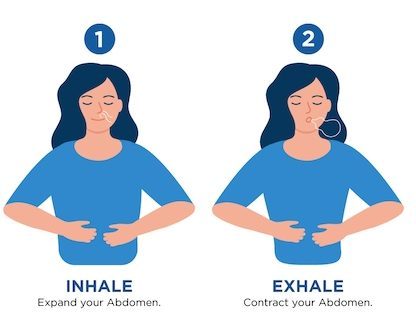Breathing techniques for COPD
Breathing exercises, specifically designed for COPD patients, offer several advantages in managing chronic obstructive pulmonary disease. These exercises go beyond conventional pulmonary rehabilitation techniques and provide individuals with a practical means of enhancing lung function and mitigating breathlessness.
Understanding COPD and its Impact on Breathing
Before delving into the breathing exercises, it's essential to comprehend the nature of COPD and how it affects breathing patterns. COPD encompasses chronic bronchitis and emphysema, both characterized by obstructed airflow and inflammation of the airways. This obstruction makes exhaling particularly challenging, leading to the accumulation of stale air in the lungs and a feeling of breathlessness.
The interplay between compromised lung function and breathing difficulties can create a vicious cycle. As individuals experience shortness of breath, they might unconsciously resort to shallow and rapid breathing, which only exacerbates the problem. The muscles responsible for respiration become overworked, leading to increased energy expenditure and a sense of fatigue.
Traditional breathing patterns do not support effective air exchange, resulting in oxygen deprivation and carbon dioxide buildup. This not only worsens breathlessness but can also negatively impact other bodily functions. It's in this context that targeted breathing exercises can play a pivotal role in managing COPD symptoms.
Breathing exercises for COPD patients
Breathing exercises are not a substitute for your COPD medication or treatment plan. They are meant to complement your medical care and enhance your well-being. You should always consult your doctor before starting any new exercise program, especially if you have severe COPD or other health conditions.
You should also pay attention to how you feel during and after the exercises. If you experience any discomfort, pain, dizziness, or worsening of your symptoms, stop the exercise and seek medical help if needed.
Diaphragmatic Breathing
Incorporating diaphragmatic breathing into your daily routine can enhance lung function and reduce breathlessness. This technique focuses on engaging the diaphragm—the primary muscle responsible for breathing—rather than relying on shallow chest movements.
Instructions:
-
Sit or lie down in a comfortable position
-
Place one hand on your chest and the other on your abdomen, just below your ribcage.
-
Inhale slowly through your nose, allowing your abdomen to expand as you fill your lungs with air. Your chest should remain relatively still.
-
Exhale gently through pursed lips, ensuring that your abdominal hand moves inward.
-
Practice this for 5-10 minutes, gradually increasing the duration as you become more comfortable.

Pursed-Lip Breathing
Pursed-lip breathing is an effective technique to slow down your breathing rate, promote relaxation, and improve oxygen exchange in the lungs. This can help alleviate the sensation of breathlessness that often accompanies COPD.
Instructions:
-
Sit or stand in a relaxed position.
-
Inhale gently through your nose for a count of two.
-
Pucker your lips as if you're about to blow out candles on a cake.
-
Breathe out steadily as you purse your lips while counting to four.
-
Repeat this pattern for several breaths, gradually increasing the inhale and exhale counts as you progress.
Learn more about pursed lip breathing:
Deep Breathing
Deep breathing, or Belly breathing is a simple but powerful breathing exercise for COPD. It helps you fill your lungs with fresh air, expel stale air, and increase oxygen delivery to your tissues. It also helps you relax and reduce stress.
Instructions:
- Sit or lie down comfortably with your back supported.
- Put one hand on your abdomen and one hand on your chest.
- Breathe in slowly and deeply through your nose, feeling your abdomen rise as it fills with air.
- Hold your breath for a few seconds, or as long as you can comfortably.
- Breathe out slowly and completely through your mouth, feeling your abdomen fall as it empties of air.
- Repeat this cycle for several minutes, or until you feel refreshed.
You can practice belly breathing once or twice a day, preferably in a quiet and peaceful environment. You can also use it when you are feeling tense or anxious.
Learn more about deep breathing:
Huff Cough
Huff cough is a special breathing exercise for COPD that helps you clear your airways of mucus and phlegm. It is also known as forced expiratory technique or huffing. It is safer and more effective than regular coughing, which can cause airway collapse and damage.
Instructions:
-
Sit or stand comfortably with your shoulders relaxed.
-
Breathe in normally through your nose, keeping your mouth closed.
-
Open your mouth and exhale forcefully, making a “huff” sound. You should feel a vibration in your chest and throat.
-
Repeat this cycle two or three times, or until you feel the mucus moving up your airways.
-
Cough gently to expel the mucus from your mouth. You may need to spit it out into a tissue or a cup.
-
Breathe normally for a few seconds, then repeat the whole process if needed.
You can practice huff cough once or twice a day, preferably in the morning or after using a bronchodilator inhaler. You can also use it when you feel congested or have a lot of mucus.
Learn how to do the Huff Cough:
Deep breathing exercises require practice
COPD Breathing exercises are an important part of managing the condition. They can help you breathe better and feel better. They can also help you prevent complications and improve your quality of life.
Incorporating simple yet effective breathing exercises into your daily routine can make a remarkable difference in managing COPD symptoms
Remember, these exercises work best when practiced consistently and under the guidance of your healthcare professional. Empower yourself with the tools to breathe better and live more comfortably with COPD.
FAQs
What are the benefits of breathing exercises for COPD?
Breathing exercises for COPD can help you improve your lung function, reduce your symptoms, enhance your quality of life, and prevent complications. They can also help you cope with stress, anxiety, and depression, which are common in people with COPD.
How often should I do breathing exercises for COPD?
You should do breathing exercises for COPD at least once a day, preferably in the morning or before bedtime. You can also do them whenever you feel short of breath or anxious. The more you practice them, the more benefits you will get.
How long should I do breathing exercises for COPD?
You should do breathing exercises for COPD for as long as you feel comfortable and benefit from them. You can start with a few minutes and gradually increase the duration as you improve. You can also vary the intensity and frequency of the exercises according to your needs and preferences.
Are there any risks or side effects of breathing exercises for COPD?
Breathing exercises for COPD are generally safe and well-tolerated by most people. However, some people may experience some discomfort, pain, dizziness, or worsening of their symptoms during or after the exercises. If this happens, stop the exercise and seek medical help if needed.
What else can I do to improve my breathing and quality of life with COPD?
Besides doing breathing exercises for COPD, you can also:
- Follow your doctor’s advice and take your medication as prescribed
- Quit smoking and avoid exposure to secondhand smoke and other irritants
- Eat a healthy and balanced diet that includes plenty of fruits, vegetables, whole grains, lean protein, and healthy fats
- Drink enough water to stay hydrated and thin out your mucus
- Exercise regularly to improve your cardiovascular fitness and muscle strength
- Maintain a healthy weight and avoid obesity
- Get enough sleep and rest to recharge your energy
- Manage stress and emotions with relaxation techniques such as meditation, yoga, tai chi, or music therapy
- Join a support group or online community to share your experiences and feelings with others who have COPD
- Educate yourself and others about COPD and its treatment options
As a leading supplier of durable and home medical equipment (DME and HME), ApriaHome sources and distributes a wide range of treatment solutions, including assistive respiratory equipment and monitoring solutions.
We're here to support you as you work toward your improved health and well-being. We strive to meet your ever-evolving healthcare requirements with individualized attention and premium quality treatment solutions.
Looking to add respiratory supplies? Browse our premium solutions and let us help you get the most out of every day.
Looking for advice? Our helpful agents are on call at (800) 780-1508 between 8:00 am - 10:00 pm EST daily. Get in touch today.





